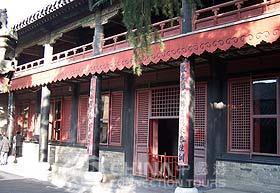 Confucius mansion, also named Shengfu, was the residence for Confucian descendants. It is the largest and grandest feudal noble mansion preserved to this day in China was erected during the Ming and Qing dynasties. It is also known as Master Yansheng's Mansion because in 1055, or the second year of the reign of Song Dynasty Emperor Zhaozhen, Kong Zongyuan, the 46th generation male descendant of Confucius was given the title "Master Yansheng. The title was passed down to Kong Decheng, the 77th generation male descendant of Confucius. The mansion arranged in three parts has 9 courtyards, 463 halls, towers, and verandas, which covers a total area of 16 hectares. The houses along the middle route are the main part of the mansion. The first four yards contain offices and the other five serve as residences. At the rear is a garden. After the death of Confucius, his decedents have always been living next to the Confucius Temple. After many times of rebuilding and expansion, it has turned into a typical feudal noble mansion combining official buildings with a residence. Covering an area of 120,000 meters, the family mansion now stores more than 9,000 volumes of files from 1534 (the 13th year of the reign of Ming Emperor Jiaqing) to 1948 and great quantities of rare and precious cultural and historical relics.
Confucius mansion, also named Shengfu, was the residence for Confucian descendants. It is the largest and grandest feudal noble mansion preserved to this day in China was erected during the Ming and Qing dynasties. It is also known as Master Yansheng's Mansion because in 1055, or the second year of the reign of Song Dynasty Emperor Zhaozhen, Kong Zongyuan, the 46th generation male descendant of Confucius was given the title "Master Yansheng. The title was passed down to Kong Decheng, the 77th generation male descendant of Confucius. The mansion arranged in three parts has 9 courtyards, 463 halls, towers, and verandas, which covers a total area of 16 hectares. The houses along the middle route are the main part of the mansion. The first four yards contain offices and the other five serve as residences. At the rear is a garden. After the death of Confucius, his decedents have always been living next to the Confucius Temple. After many times of rebuilding and expansion, it has turned into a typical feudal noble mansion combining official buildings with a residence. Covering an area of 120,000 meters, the family mansion now stores more than 9,000 volumes of files from 1534 (the 13th year of the reign of Ming Emperor Jiaqing) to 1948 and great quantities of rare and precious cultural and historical relics.
